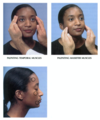Flashcards for Midterm Exam
(155 cards)
Labs and Diagnostic Testing: CBC, H&H
Consider:
- Proposed surgery
- Potential blood loss
- Clinical indications: hematologic dx, chronic kidney/liver dz, anticoagulants, etc.
- NICE guidelines: ASA-PS 3 or 4 intermediate procedures, all pts having major procedures
Lab and Diagnostic Testing: Electrolytes
Clinical indications for electrolytes:
- chronic kidney dx
- cirrhosis
- certain meds
- DM
- dialysis
- type of surgery
Lab and Diagnostic Testing: Glucose
- Clinical indications for glucose: DM, steroid use, cirrhosis
Lab and Diagnostic Testing: Renal Function
- Assess tubular function & GFR
- Clinical indications: HTN, DM, dehydration, renal dx, h/o transplant, etc.
-
NICE guidelines:
- Routine: ASA 3 or 4 having intermediate procedure & ASA 2, 3, or 4 having major procedure
- Risk for AKI: ASA 3 or 4 having minor procedure, ASA 2 for intermediate
Lab and Diagnostic Testing: Liver Function
- History of liver injury & exam findings
- Clinical indications: hepatitis, jaundice, cirrhosis, portal HTN, bleeding disorders, etc.
Lab and Diagnostic Testing: Coagulation Profile
- Routine testing not indicated unless known or suspected coagulopathy
- Clinical indications: bleeding disorder, anticoag meds, liver dx
- NICE guidelines: ASA 3 or 4; intermediate, major, complex procedures; anticoag meds or chronic liver dz
Lab and Diagnostic Testing: Urinalysis
- No indication for routine use
- Clinical indications: suspected UTI, unexplained fever or chills
Lab and Diagnostic Testing: T&S, T&C
- Decision usually guided by institution policy (surgical blood order schedule)- reduce unnecessary blood order$
- Clinical indications: suspect blood transfusion
Lab and Diagnostic Testing: ECG
- No indication for routine use
- Clinical indications: h/o IHD, HTN, DM, HF, CP, syncope, DOE, etc.
- 2014 ESC/ ESA guidelines: risk factors for IHD, CVD, sig. arrhythmia, or symptomatic; intermediate/ high risk surgery
- NICE guidelines: ASA 3 or 4 intermediate procedure; ASA 2, 3, or 4 major procedures
Lab and Diagnostic Testing: Chest X-ray
- No indication for routine use
- Clinical indications: advanced COPD; bullous lung disease; suspected: pulmonary edema, pneumonia, mediastinal mass; suspicious findings on exam
- Patients undergoing thoracic, upper abdominal, AAA surgery
Lab and Diagnostic Testing: ECHO
- No indication for routine use
- Clinical indications: heart murmur and symptomatic, S&S of HF, unexplained dyspnea
- Clinically stable, ventricular dysfunction not tested in previous year
Lab and Diagnostic Testing: PFT’s
- Considered for type and invasiveness of surgery (CABG, lung resection)
-
Clinical indications:
- severe asthma
- symptomatic COPD
- scoliosis
- restrictive lung dx
Patients considered “Aspiration Risk”
- Age extremes <1 or >70
- Prematurity
- Pregnancy
- Ascites (ESLD)
- Neurologic dz
- Collagen vascular dz, metabolic disorders (DM, obesity, ESRD, hypothyroid)
- Hiatal Hernia/GERD/Esophageal surgery
- Mechanical obstruction (pyloric stenosis)
- Having eaten food or non-clear drinks
Continue meds day of surgery except…
- ACEIs and ARBs
- ASA: stop 3 days prior unless PCI, high-grade IHD, sig. CVD
- P2Y12 inhibitors: stop 5-10 days prior unless drug-eluting stent (6-month dual antiplatelet therapy) & bare metal stents (1-month dual antiplatelet therapy) *** Discuss risk w/ surgeon/ cardiologist
- Warfarin: stop 5 days prior
- NSAIDS: 48 hrs prior
- Short-acting insulin; none or ½ dose of long-acting insulin day of *** insulin pump- basal rate only
- Non-insulin antidiabetic meds (metformin →lactic acidosis)
- Topical
- Diuretics
- Sildenafil or similar
Cardiovascular Assessment
Renal Failure
- ↑CO – compensation for ↓ O2 carrying capacity
- HTN – Na+ retention, RAAS activation
- LVH common
- CHF w/ pulmonary edema after limits of compensation reached
- Deposition of Ca++ - in conduction system & on heart valves
- Arrhythmias – electrolyte imbalances
- Uremic pericarditis – can be asymptomatic, chest pain, tamponade, usually 2◦ to inadequate dialysis
- Accelerated CAD, PVD
Fluid Balance Assessment
Renal Failure
•Fluid overload VS intravascular depletion s/p dialysis/ aggressive diuretic therapy
- Body weight
- VS (orthostatic hypotension & tachycardia)
- Atrial filling pressures
Pulmonary Assessment
Renal Failure
- ↑ MV to compensate for metabolic acidosis
- ↑ pulmonary extravascular water = interstitial edema = widened alveolar/arterial O2 gradient
- “Butterfly wings” on CXR 2⚬ to ↑ permeability of alveolar capillary membrane (edema even with normal PCWP)
Endocrine Assessment
Renal Failure
- Peripheral resistance to insulin = poor glucose tolerance
- Hyperparathyroidism = prone to fractures
- Abnormal lipid metabolism = accelerated atherosclerosis
- Kidneys do not degrade hormones and proteins normally = increased circulating PTH, insulin, glucagon, GH, LH, PL
Normal Na+
135-145 meq/L
Normal K+
3.5-5 meq/L
Normal Cl-
95-105 meq/L
Normal HCO3-
Venous: 19-25 meq/L
Arterial: 22-26 meq/L
Normal Ca++
4.5-5.5 meq/L
Normal Phosphate
2.4-4.7 mg/dL




